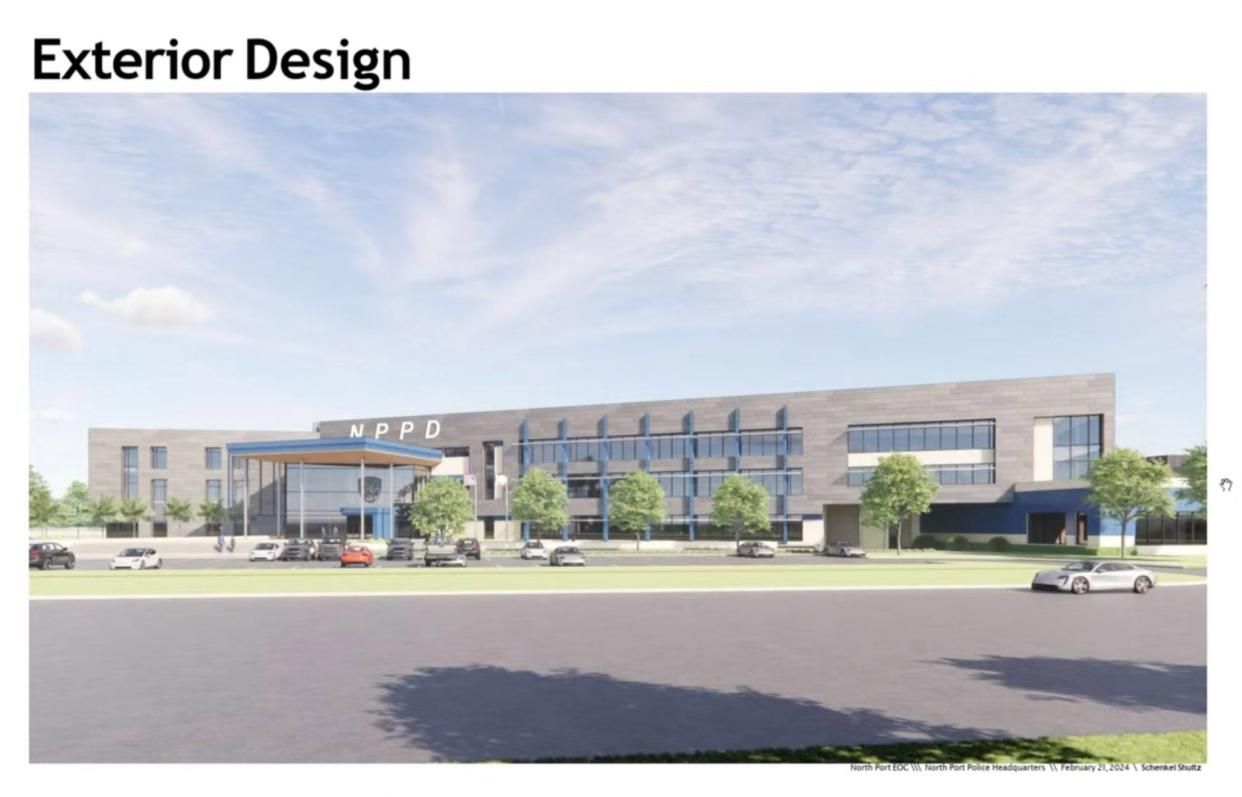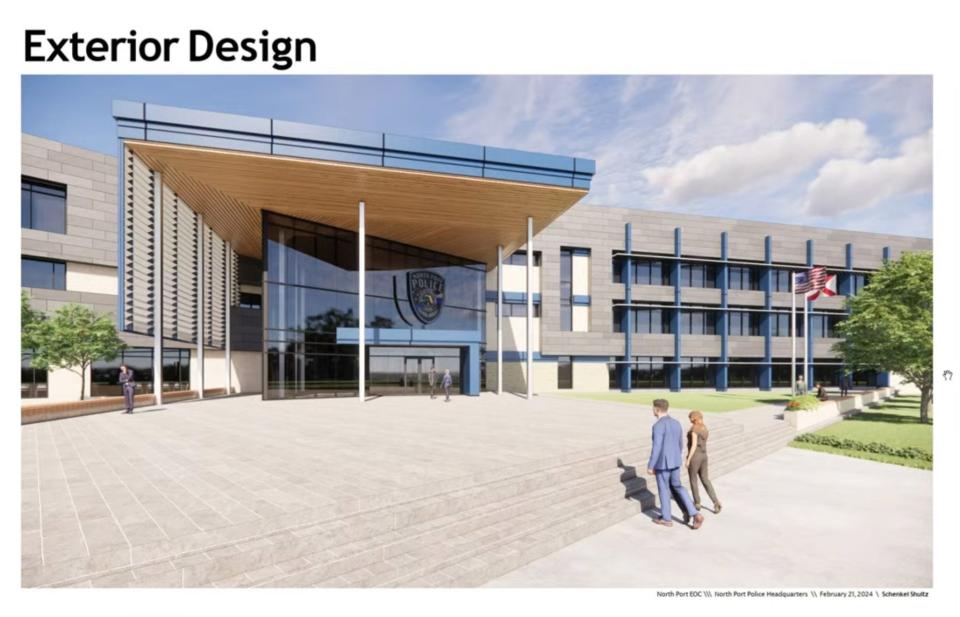North Port sets sights on $122.7 million police station; eyes multiple funding sources

Correction: a 6.8% increase in property taxes that could finance a $35 million bond issues would add about $51.24 a year to the tax bill of a home valued at $200,000. An earlier version of this story listed an incorrect figure.
NORTH PORT – North Port city commissioners opted for construction of a $122.7 million Police Station, identified about $100.6 million in funding sources and even expressed an interest in selling the 83-acre Warm Mineral Springs Park at a Thursday afternoon special meeting to discuss the law enforcement center.
Though the board committed to pursuing 100% design documents for the station, none of the potential funding sources are definite.
Proceeds from a possible sale of Warm Mineral Spring to the state or a conservation group did not factor in that $100.6 million sum.
There are still several milestones to reach before plans are solidified, but the commission gave City Manager Jerome Fletcher and his staff direction on what they expect to see next.
“This is not an effort of finding one funding source, it’s an effort of multiple funding sources,” Fletcher said.
Though the issue not officially on the schedule yet, Fletcher said residents can comment at 6 p.m., March 21, at City Hall, at a community question and answer session that will also be livestreamed via YouTube.
North Port department bursting at the seams
The current 32,400-square-foot Police Station opened in July 2006. Since then the city’s population has grown from 47,000 to more than 86,000 people and the police force from 79 sworn officers and 30 civilian employees to 144 sworn offices and 52 civilian employees, with 10 more officers possible through a new federal grant.

To keep pace with population growth, city officials want to build a 108,900-square-foot main building, 7,400-square-foot special operations garage and 5,230-square-foot vehicle uplift garage on 19.2 acres off of Toledo Blade Boulevard projected to be spacious enough to accommodate agency growth through 2065.
Commissioners endorsed the approach on a 4-1 vote.
Commissioner Barbara Langdon dissented, as she favored cutting the price by building less than 30,600 square feet of enclosed “shell” space that may not be needed for decades.
That design – accommodating for projected needs through 2050 – could shave as much as $9 million on the initial cost. The downside is inflation could more than triple the cost of building that space in the future. Postponing other aspects of the campus would bring the cost down to $100 million.
Langdon said she felt that a future North Port – enriched by a more robust commercial and industrial tax base – would be better equipped to cover that tab.
“I just think that, in balance, we’re putting potentially a lot of burden on the people who live here today for capacity 25 years from now, 40 years from now, when I really do believe the city will be a much better position in 25 years" to pay for more space, Langdon said. “The numbers are so big and the struggle is real, trying to find the right balance.”
Vice Mayor Phil Stokes wanted to see the city explore hiring an outside entity to build the facility and engage in a lease buy back program that would not require the city to identify and secure $122 million all at once.
During a Feb. 26 workshop, Deputy Police Chief Chris Morales voiced concern that might lead to the city receiving a lesser product than they wished, as the developer sought to increase its profit margin.
Regardless of how the city chooses to pay for the station, it would negotiate a guaranteed maximum price prior to construction.
$100 million and counting
Either Langdon's or Stokes’ preferred options may yet be employed as Fletcher and his staff piece together funding sources, though the lion’s share will be covered through issuing up to $85 million in bonds that city voters would have to approve through a referendum.
The current plan is to have that question placed on the Aug. 20 primary ballot rather than in the more crowded Nov. 5 general election.
About $50 million of those bonds would be covered from funds collected through the recently approved half-cent sales tax – though to accomplish that, funds allocated for the second phase of widening Price Boulevard would be deferred until after the vote to renew the sales tax in 2039.
The other $35 million would come from a 6.8% increase in the property tax rate which adds another $51.24 a year to the tax bill of a home valued at $200,000, Fletcher said.
Commissioner Debbie McDowell suggested that other sales tax projects could be cut or deferred to lower the prospective property tax increase.
A projected $7 million could be raised through the city selling the current police station to the Development Services Department, which currently has about $10 million in its building fee funds available to pay for an expansion.
Development Services Director Alaina Ray noted that the department is suffering the same growing pains as the police department, with former conference rooms being shared by four employees as an office.
“We are in dire need, we are busting at the seams on the first floor,” Ray said.
That would bring the total to $92 million.
The possible sale of three city owned properties – a 47-acre potential park site on Italy Avenue; six-acres owned by Road and Drainage on Price Lane and an acre of commercially-zoned land owned at 5601 Sumter Boulevard – could bring in as much as $8.6 million.
The sale of the Italy Avenue site, which is valued at $7 million, is the most controversial of that bunch, since it had long been projected to be the location for an east-side community center.
Warm Mineral Springs funding
Four of the five commissioners say they are willing to sell Warm Mineral Springs Park to an entity that will conserve the property, something long championed by a vocal segment of residents.
The price would need to be determined. The city had the 61.4-acre park portion of the parcel appraised at $16.4 million but there was no value established for the springs, on 21.6 acres.
Stokes said the springs – annexed into the city limits in the early 2000s – is too much a part of the city and he would not immediately be in favor of selling them.
Langdon stressed that the city never intended to actually operate Warm Mineral Springs and taking on management of the property after Hurricane Ian was considered temporary until the now defunct public-private partnership would take over.
“I just don’t think that’s the business we should be in,” Langdon said.
Mayor Alice White cautioned that the city still needed to research whether accepting state conservation funding would result in pure preservation, with bathers banned from the springs.
McDowell, who has long championed the thought of a nonprofit similar to The Bay Park Conservancy in Sarasota assuming control of the springs, said she had talked with Jon Thaxton, senior vice president for community leadership for the Gulf Coast Community Foundation, about helping facilitate the creation of a similar partnership.
McDowell also said Fletcher and Thaxton are also expected to talk about that possibility.
Thaxton confirmed that and noted that several community members have contacted him about Gulf Coast assisting with that effort.
He added that no commitments had been made by either side.
Use of impact fees, grants and Resilient SRQ funding
The board also discussed using impact fees, though a new study of the fees would be needed.
Fletcher said the city would also apply for state and federal grants for the police station but any funds awarded would likely be used to reduce the value of bonds sold.
Fletcher said the city would seek as much as $20 million in funding from the $201.5 million Resilient SRQ federal block grant program for post Hurricane Ian recovery.
That sum would be in addition to applications made to upgrade water control structures and shore up the city’s roadway network.
Funding for the police station from that source may be a long shot. While the program has $70 million available for public facilities projects, $25 million of that is specifically earmarked for the widening of River Road between U.S. 41 and Englewood.
That leaves $45 million for projects proposed by North Port, Sarasota County, other municipalities and area nonprofits.
“If it qualifies or if the county allows it to be selected,” Fletcher said, “it would be an immense help to this project.”
This article originally appeared on Sarasota Herald-Tribune: North Port starts process to fund a $122.7 million police station

